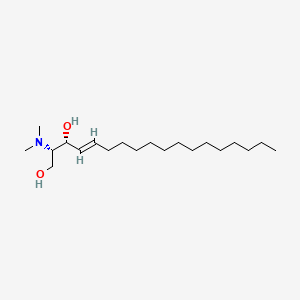N,N-dimethylsphingosine
N,N-dimethylsphingosine is a lipid of Sphingolipids (SP) class. N,n-dimethylsphingosine is associated with abnormalities such as Exanthema and Increased drug resistance. The involved functions are known as Vmax, Metabolic Inhibition, Anabolism, Binding (Molecular Function) and Cytokinesis. N,n-dimethylsphingosine often locates in yolk, Membrane, CNS - Brain (MMHCC), soluble and Tissue membrane. The associated genes with N,N-dimethylsphingosine are FPR1 gene, ANP32A gene, HPGDS gene, Nuclear phosphoprotein and PTGS2 gene. The related lipids are Sphingolipids, Phosphatidic Acid, Lysophosphatidylcholines, stearylamine and dihydroceramide. The related experimental models are Mouse Model and Knock-out.
References related to genes published in Others
| PMID | Journal | Published Date | Author | Title |
|---|---|---|---|---|
| 19147754 | Clin. Cancer Res. | 2009 | Song Y et al. | Sp-1 and c-Myc mediate lysophosphatidic acid-induced expression of vascular endothelial growth factor in ovarian cancer cells via a hypoxia-inducible factor-1-independent mechanism. |
| 17251460 | Invest. Ophthalmol. Vis. Sci. | 2007 | Xu KP et al. | Lysophosphatidic acid promoting corneal epithelial wound healing by transactivation of epidermal growth factor receptor. |
| 10605030 | J. Immunol. | 2000 | Chuang FY et al. | Convergence of Fc gamma receptor IIA and Fc gamma receptor IIIB signaling pathways in human neutrophils. |
| 10969794 | Cancer Res. | 2000 | Nava VE et al. | Sphingosine enhances apoptosis of radiation-resistant prostate cancer cells. |
| 10898727 | Am. J. Physiol., Cell Physiol. | 2000 | Souktani R et al. | Induction of apoptosis using sphingolipids activates a chloride current in Xenopus laevis oocytes. |
| 17504945 | Mol. Pharmacol. | 2007 | Kim HJ et al. | Suppression of osteoclastogenesis by N,N-dimethyl-D-erythro-sphingosine: a sphingosine kinase inhibition-independent action. |
| 16831409 | Cardiovasc. Res. | 2006 | Jin ZQ and Karliner JS | Low dose N, N-dimethylsphingosine is cardioprotective and activates cytosolic sphingosine kinase by a PKCepsilon dependent mechanism. |
| 24149004 | Stroke | 2013 | Leitzke AS et al. | Isoflurane post-treatment ameliorates GMH-induced brain injury in neonatal rats. |
